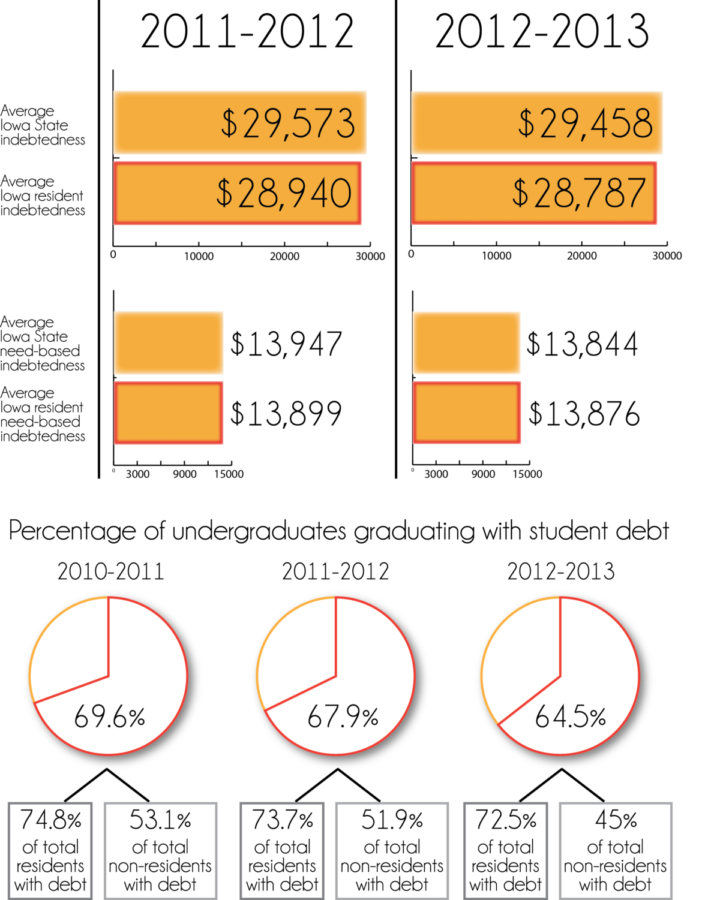ISU students may face above-average debt
May 6, 2014
Phillip Truong is part of the 65 percent.
That 65 percent represents the amount of students from Iowa State who take out loans and graduate with debt.
Iowa is ranked sixth in the nation when it comes to student debt.
ISU students have the average highest debt among the three regent universities of Iowa State, University of Iowa and Northern Iowa.
According to the Board of Regents April docket item, the national average of indebtedness for those who are graduating with debt was $25,500 in 2011-12. Iowa State’s average was $29,573.
On a national basis, about 57 percent of undergraduate seniors in 2012-13 graduated with debt. At Iowa State, that percent was about 64.5 according to the regents’ docket item.
The average debt load for ISU students who graduated with debt in 2012-13 was $29,458, a decrease from the previous year.
Truong, graduating with a degree in supply chain management with a minor in management, said he will be graduating with about $45,000 in debt. About $30,000 of this is from the Federal Application for Student Aid, he said, with the rest from Wells Fargo Bank.
With four older siblings who also attended Iowa State, Truong said he just did not have the money to pay for school out-of-pocket.
“That’s something I knew beforehand — that I was going to have to take out quite a bit,” Truong said. “But I didn’t have any other choice.”
Roberta Johnson, director of student financial aid, said often when students come in as freshmen, their parents handle a lot of their financial obligations for them. She said the office of financial aid understands this, but that the challenge comes when students don’t realize the loans are in their name and they must pay them back.
“It behooves the student to understand that even though mom and dad may say it’s a good idea to take out that debt, they need to make their own decision about whether or not they want to incur that debt,” Johnson said. “It should be a good conversation between the student and their parents as opposed to blankly telling the student to take out those loans.”
Johnson said students should only get a loan if they are unable to fund their educational costs through any other means. She also said to only borrow for educational costs such as tuition, room and board or books instead of personal living expenses.
Personal living expenses are calculated as an estimate into the projected cost of attendance and is about $2,500 per year, Johnson said.
Scholarships and part time jobs are ways to help reduce a student’s post-graduation debt load, Johnson said.
“It’s pretty feasible for a student to be able to earn around $2,500 over the course of an academic year if they’re working about 12-15 hours a week at a minimum wage job,” Johnson said.
Johnson also said students should look at how they spend their money and cut back on expenses.
If students still feel they need to take out a loan, Johnson said they should fill out the Federal Application for Student Aid [FAFSA] before taking out private loans from a bank or a a service such as Sallie Mae.
“We are always pushing federal loans first,” Johnson said.
Federal loans typically have lower interest rates and more borrower benefits and protections, Johnson said.
Subsidized federal loans do not accumulate interest while the student is in school, Johnson said. Private loans, however, start to accumulate interest as soon as the money is received.
“While you may be able to defer making payments on them by the time you graduate, you may have three or four years’ worth of unpaid interest that has accumulated on your loan,” Johnson said.
Unsubsidized Stafford loans typically have a fixed, lesser amount, interest rate, Johnson said.
Because of these loan differences, Johnson said the office of student financial aid requires new private loan borrowers to come into the office.
“We help them to look at what their repayments are going to look like when they get out of school and help them to at least be more aware so they can be more conscientious about whether they want to take out that debt or not,” Johnson said.
Johnson said a great tool students could use to help them plan their budget is the Financial Awareness Counseling Tool, or FACT, found at www.studentloans.gov.
Students sign in with the same identifiers they have for applying for the FAFSA: social security number, first two letters of their last name, date of birth and four-digit pin number.
The site will pull up information about what the student has already borrowed and how much it’s going to cost to pay back that amount.
“The amount of money you’ve already borrowed is going to blaze at you,” Johnson said.
The site also helps students figure out interest rates and then they can look at different repayment options.
Iowa State also offers a loan repayment estimator on AccessPlus. Based on what the financial aid office knows about the student, it can calculate the gross debt and how much it will cost per month, Johnson said.
Truong said he took the exit counseling through financial aid office to help him figure out how much he will repay every month for 10 years.
Johnson said seniors regularly come into the financial aid office nervous about their debt.
“At that point, you’ve borrowed what you’ve borrowed. We can’t change that,” Johnson said. “What we do talk about is the variety of repayment options that are available to them.”
There are a variety of repayment plans, Johnson said, but the most often used is the standard plan. This option allows students to repay their debt over the course of 10 years. Other plans include stretching the plan to 30 years or a stair step plan that allows students to increase repayment increments every two years or so.
Johnson said students can walk into the student financial aid office any time throughout the year. Calling ahead helps the office prepare the student’s information, Johnson said.
Johnson said she always tells students, “the cheapest loan you will ever have is the loan you don’t take out.”







